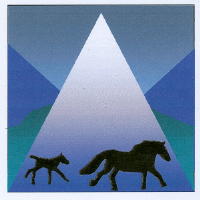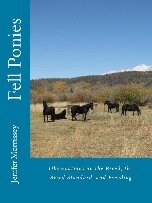The first snake encounter of the day was when I was walking my pregnant Fell Pony mare Willowtrail Wild Rose from the barn to her foaling pen for the day. We walked down into a ravine, and as we descended, I was watching for snakes, when I saw one just in front of me. Before I could stop, Rose had stepped on it. But because I stopped, she did too, on the snake. Well-mannered pony except in this case! I quickly asked her to move ahead then I turned around to see what we had just passed over. It was a baby snake, and it was hissing at us and appeared to be injured, so I went off in search of a rock to put it out of its misery. When we returned, the foot-long youngster was slithering off, and I confirmed that it was a harmless bull snake, so I tossed my rock aside and willed my heart to quit beating so quickly.
A few minutes later, as I was settling Rose into her pen, I heard my young dog Ace barking insistently. This is the same dog that was bit by a rattlesnake a few weeks before. When I stepped around the shed to see where he was, I saw he was barking at a spot on the ground, with my other dog doing an approach-and-retreat dance I’d seen her use at other times this summer around snakes. For herding dogs, these two do amazing imitations of pointers! I quickly grabbed a pitchfork and yelled at the dogs to keep their distance and approached them quickly but cautiously. I scanned the ground where they were pointing, and I couldn’t see anything. Then I drug the pitchfork across the area the dogs were pointing at, and something silver moved and both dogs jumped. It was a snake skin! Once again I willed my heart to quit beating so quickly while smiling at the harmless outcome of our collective excitement.
The previous day I was emerging from a bad case of heat exhaustion, my second of the summer after not having any cases for years. In addition, I had been pondering the news reports from earlier in the week of the just-released report from the Intergovernmental Panel on Climate Change. The summary seems to be that the climate will be getting hotter and more unpredictable quickly. The two summers I have been here in South Dakota have been hotter than normal, but I can’t take solace from that statistical perspective because these hot days may be our new normal. So I’ve been asking myself how my stewardship of my ponies needs to be adjusted.
At first I was thinking about it from the ponies’ perspective. What do they need that they don’t already have? The good news is that they seem to be doing pretty well so far, making use of sheds and barns to stay out of the sun during the day, availing themselves of cooling breezes, and doing most of their grazing at night. After my heat exhaustion, I then had to ask, what do I need to do differently? Immediately what came to mind is the timing of my breeding and foaling season and the workload they require. In Colorado I hadn’t ever been constrained by weather with regard to breeding and foaling, but I know one breeder elsewhere that has timed foaling for the dead of winter because of their climate. In the face of the hot days I’ve experienced this summer and last, and maybe hotter ones in the future, I will probably have to move my breeding and foaling to early spring and late fall so I don’t have a workload during weather I can’t handle.
Warmer summers may mean a longer snake season, too. I lived without snakes for seventeen years when I was in Colorado at 9,000 feet above sea level, so I haven’t been used to constraining my life because of them. And the long cool season here when they aren’t out lulls me to complacency for many months. Having Ace bit each year of his life so far by rattlesnakes, though, has established a pattern that I can’t ignore. I know the snakes aren’t necessarily aggressive; I remember watching one of my ducks once step on a rattlesnake with no adverse consequences (except for the snake getting quickly relocated out of the barnyard!) Nonetheless, I will be evaluating how my management of my ponies may need to change to keep us all safe from snake bites and, more importantly, how to minimize my anxiety about them. I wonder what other aspects of our new climate normal will require me to rethink my stewardship of my ponies.
A few days before my snakes-in-the-morning, a friend let me know about a rattlesnake awareness class she was taking her dog to. My neighbor Bruce laughed when I told him about it, saying I was getting my awareness through on-the-job training! I am just thankful that my dogs are being cautious and letting me know when they have found something serpent-like, even if it’s just a skin!
© Jenifer Morrissey, 2021









































